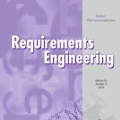Context: Regulations, such as the European Accessibility Act (EAA), impact the engineering of software products and services. Managing that impact while providing meaningful inputs to development teams is one of the emerging requirements engineering (RE) challenges. Problem: Enterprises conduct Regulatory Impact Analysis (RIA) to consider the effects of regulations on software products offered and formulate requirements at an enterprise level. Despite its practical relevance, we are unaware of any studies on this large-scale regulatory RE process. Methodology: We conducted an exploratory interview study of RIA in three large enterprises. We focused on how they conduct RIA, emphasizing cross-functional interactions, and using the EAA as an example. Results: RIA, as a regulatory RE process, is conducted to address the needs of executive management and central functions. It involves coordination between different functions and levels of enterprise hierarchy. Enterprises use artifacts to support interpretation and communication of the results of RIA. Challenges to RIA are mainly related to the execution of such coordination and managing the knowledge involved. Conclusion: RIA in large enterprises demands close coordination of multiple stakeholders and roles. Applying interpretation and compliance artifacts is one approach to support such coordination. However, there are no established practices for creating and managing such artifacts.
翻译:暂无翻译





